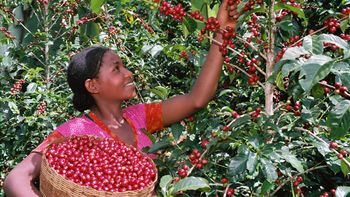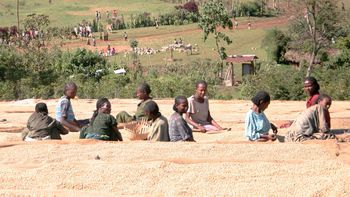Click here to register!
Difference between revisions of "Improving Coffee Production and Quality Using Infrared Technology"
***** (***** | *****) |
***** (***** | *****) |
||
| Line 64: | Line 64: | ||
= Progess Update<br/> = | = Progess Update<br/> = | ||
| − | HoA-REC&N has been working on developing a biogas digester and an Infrared (IR) Dryer to dry coffee beans. Over the past few months HoA-REC&N constructed and commissioned four bio digesters which were tested with two different coffee feedstocks–husk and pulp. The tests showed that the coffee pulp resulted in higher yields of bio-methane. Additional experiments were conducted to analyze the effectiveness of coffee drying at different temperatures and power. In collaboration with one of their partners, University of Massachusetts-Boston, HoA-REC&N has finished putting together technical specifications for the IR Dryer. Finally, HoA-REC&N has selected the Kenterie coffee cooperative, comprised of 1520 members, as the site to pilot their technology. | + | HoA-REC&N has been working on developing a biogas digester and an Infrared (IR) Dryer to dry coffee beans. Over the past few months HoA-REC&N constructed and commissioned four bio digesters which were tested with two different coffee feedstocks–husk and pulp. The tests showed that the coffee pulp resulted in higher yields of bio-methane. Additional experiments were conducted to analyze the effectiveness of coffee drying at different temperatures and power. In collaboration with one of their partners, University of Massachusetts-Boston, HoA-REC&N has finished putting together technical specifications for the IR Dryer. Finally, HoA-REC&N has selected the Kenterie coffee cooperative, comprised of 1520 members, as the site to pilot their technology.<ref name="Powering Agriculture: http://poweringag.org/innovators/improving-coffee-production-quality-using-infrared-technology">Powering Agriculture: http://poweringag.org/innovators/improving-coffee-production-quality-using-infrared-technology</ref><br/> |
<br/> | <br/> | ||
Revision as of 13:21, 21 November 2017
Overview
|
Innovator |
Horn of Africa Regional Environment Center and Network—Addis Ababa University |
|
|
Project |
Improving Coffee Production and Quality Using Infrared Technology | |
|
Collaborators |
University of Hohenheim (Germany) | |
|
Location Applied |
Coffee accounts for 60 percent of the export earnings in Ethiopia, and is processed by dry and wet processing. Wet processed is preferred in the global market. Unfortunately, farmers do not see the full benefit of their coffee production. A significant portion of coffee harvested is of inferior quality due to the traditional sun drying process. This process can take up to twelve days and increases exposure of coffee to fungi and other undesirable elements. Thermal drying is energy intensive and takes up a large amount of space.[1]
Clean Energy Solution
The proposed solution uses state of the art infrared technology to reduce coffee pulp drying time from several days to hours. Reduced drying time minimizes the post-harvest loss that occurs when using the conventional sun drying process. Biogas generated from coffee pulp and coffee husk will be used to power the bioreactors used for infrared drying.[1]
Impact
The project will significantly reduce the time farmers spend processing their crop. This time saved can be used for other more productive activities. Converting waste products from coffee production into useful energy reduces greenhouse gas emissions. The project will also improve work conditions for women and children, who are primarily responsible for the sun drying process which requires all-day exposure to the sun. In addition, the project will provide alternative livelihoods for the woman by engaging them in mushroom production from coffee husk.[1]
Organization
The Horn of Africa Regional Environment Center and Network (HoA-REC&N) is an autonomous institution under Addis Ababa University. HoA-REC&N focuses on environmental concerns and sustainable development options within the Horn of Africa. Partner institutions include University of Hohenheim; University of Massachusetts–Boston; and the Oromia Coffee Farmers Cooperative Union.[1]
Progess Update
HoA-REC&N has been working on developing a biogas digester and an Infrared (IR) Dryer to dry coffee beans. Over the past few months HoA-REC&N constructed and commissioned four bio digesters which were tested with two different coffee feedstocks–husk and pulp. The tests showed that the coffee pulp resulted in higher yields of bio-methane. Additional experiments were conducted to analyze the effectiveness of coffee drying at different temperatures and power. In collaboration with one of their partners, University of Massachusetts-Boston, HoA-REC&N has finished putting together technical specifications for the IR Dryer. Finally, HoA-REC&N has selected the Kenterie coffee cooperative, comprised of 1520 members, as the site to pilot their technology.[1]
Further Information
- Ethiopia Energy Situation
- Website Powering Agriculture Homepage, Winners/ Innovators
- Powering Agriculture: An Energy Grand Challenge for Development
- Website Horn of Africa
- Website Oromia Coffee Farmers Cooperative
- Powering Agriculture Newsletters






















